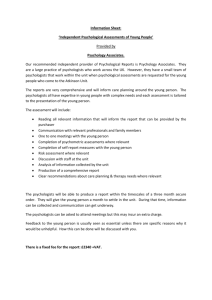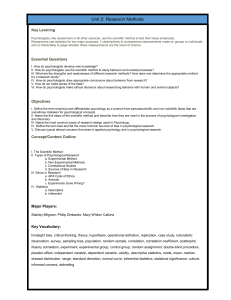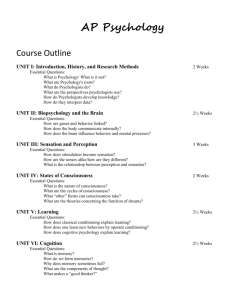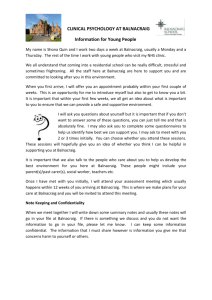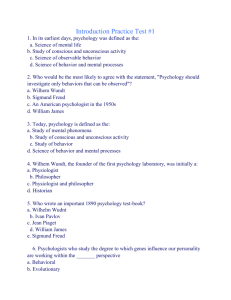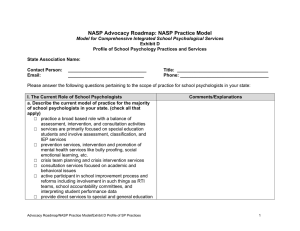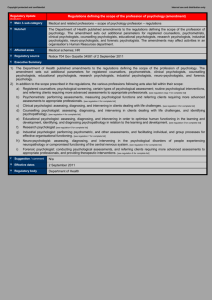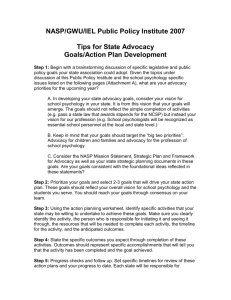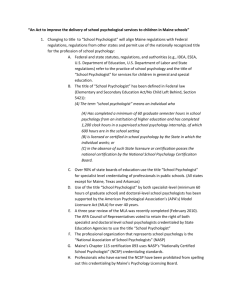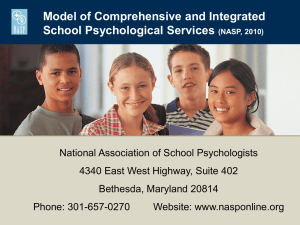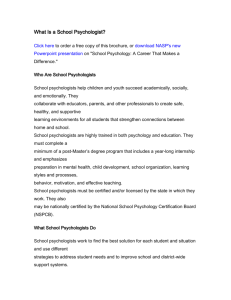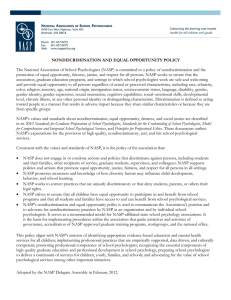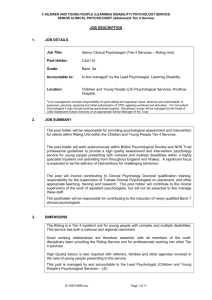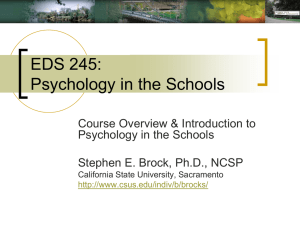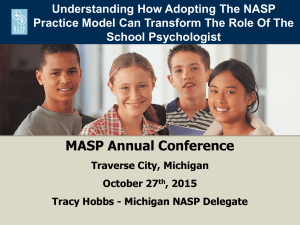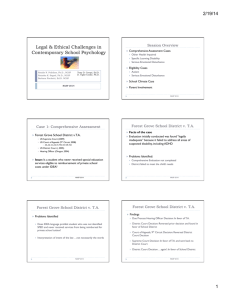NASP Model for Comprehensive Integrated SP Services
advertisement
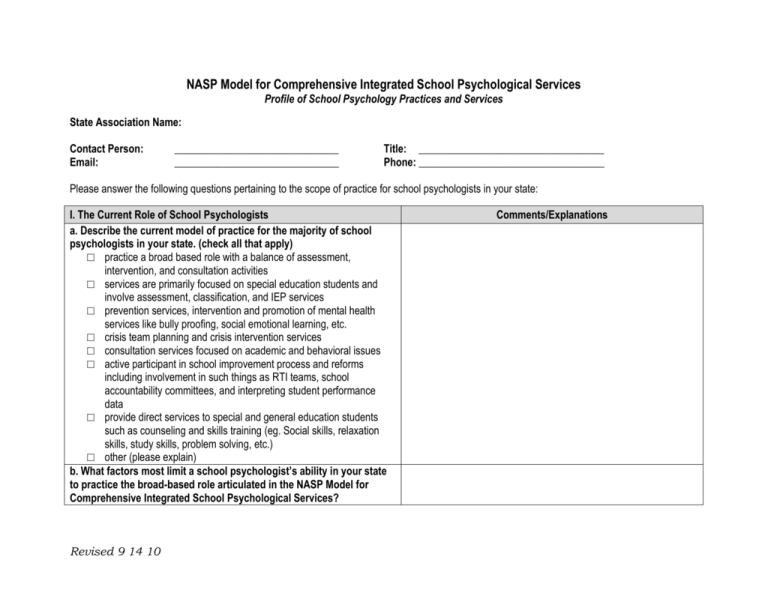
NASP Model for Comprehensive Integrated School Psychological Services Profile of School Psychology Practices and Services State Association Name: Contact Person: Email: _______________________________ _______________________________ Title: ___________________________________ Phone: ___________________________________ Please answer the following questions pertaining to the scope of practice for school psychologists in your state: I. The Current Role of School Psychologists a. Describe the current model of practice for the majority of school psychologists in your state. (check all that apply) □ practice a broad based role with a balance of assessment, intervention, and consultation activities □ services are primarily focused on special education students and involve assessment, classification, and IEP services □ prevention services, intervention and promotion of mental health services like bully proofing, social emotional learning, etc. □ crisis team planning and crisis intervention services □ consultation services focused on academic and behavioral issues □ active participant in school improvement process and reforms including involvement in such things as RTI teams, school accountability committees, and interpreting student performance data □ provide direct services to special and general education students such as counseling and skills training (eg. Social skills, relaxation skills, study skills, problem solving, etc.) □ other (please explain) b. What factors most limit a school psychologist’s ability in your state to practice the broad-based role articulated in the NASP Model for Comprehensive Integrated School Psychological Services? Revised 9 14 10 Comments/Explanations (check all that apply) □ remote access such as rural settings □ limited resources □ training of the SP □ high student to SP ratios □ performance appraisal more narrow than the Practice Model □ state guidelines/regulations delineate different services than the Practice Model □ limits imposed by administrators □ other (please explain) c. How are school psychologist positions typically funded in your state? (check all that apply) □ through Local Educational Agency funds (school districts) □ through State Education Agency funds (State Department of Educ) □ through grant funds □ other (please explain) How does this funding approach impact the role that school psychologists fulfill? □ role is determined at the local level □ role is dictated by state mandates/regulations/guidelines □ role is outlined by description in grant □ not at all □ other (please explain) d. Does your state have a policy or regulation recommending a student to school psychologist ratio? YES or NO If so, what is the ratio? How does this ratio compare to the new standards (500-700 students for every school psychologist practicing a broad based role) in the Model? Where in public policy is the recommended ratio explicitly stated? (statutes, regulations, or board policies) Revised 9 14 10 e. What is the current trend regarding school psychologist positions? □ significant reductions □ position increases □ things generally are status quo What factors are most impacting this issue? II. School Psychology Credential or License Comments/Explanations a. What agency or regulatory body has the primary authority for credentialing/licensing school psychologists for practice in schools? What is the specific statutory/regulatory reference or website address where the statutes and/or regulations can be found pertaining to SP credentials/licenses? What is the title of the SP credential/license? What are the related required credentialing standards? (e.g. 60-hour program, NCSP, 1200 internship, etc.) b. What definitions of school psychology practice exist in your state? Provide examples with citations if possible. Consider: □ local school board policies □ state statutes (laws) □ state regulations (typically issued by your state departments of education) □ None of the above? c. How consistent are your state’s existing definitions and standards for practice with the new NASP Model for Delivery of Comprehensive and Integrated School Psychological Services? Domain 1: Data based decision making and accountability Domain 2: Consultation and collaboration Domain 3: Interventions and instructional support to develop academic skills Revised 9 14 10 II.c.Item rating: For each domain listed on the left, identify in the space below if the current related state definitions/standards are Consistent, Somewhat Consistent, or Not Consistent. Domain 4: Interventions and Mental health services to develop social and life skills Domain 5: Diversity in development and learning Domain 6: School-wide practices to promote learning Domain 7: Preventive and responsive services Domain 8: Family-school collaboration services Domain 9: Research and program evaluation Domain 10: Legal, ethical, and professional practice III. Promotion of School Psychology a. Which of the following has your state ever pursued? (check all that apply) □ Resolution honoring National School Psychology Awareness Week □ Resolution honoring school psychologists and the value of school psychological services □ Recognition of school psychologist(s) of the year □ Participate in School Psychology Awareness Week activities □ Use NASP communications and advocacy resources (e.g. adaptable handouts, roadmaps) □ Customized marketing materials about the role of school psychologists or school psychological services □ Training individual school psychologists to promote their services at the local level □ Media spots (e.g. TV commercial, radio, print ad) □ Promotional public services (e.g. sponsor a highway program, charity events, etc.) □ Professional presentations (e.g. to other stakeholder groups, school boards, etc.) □ Awards for policy makers who support school psychologists and school psychological services Revised 9 14 10 Comments/Explanations □ Specific legislation supporting school psychology or school psychological practices □ Broad dissemination of information about School Psychology (e.g. Capitol Hill day, exhibit booth at a legislator’s conference, mailings to stakeholder groups, etc.) □ Other? (Please describe) b. What coalitions or collaborations with other stakeholder groups is your state association currently pursuing or participating in? (Check all that apply) □ teacher associations □ administrative associations □ other related services associations □ school boards associations □ psychological associations □ state agencies □ parent groups □ student groups □ other (please explain) c. Who are your “state-level decision makers” that are currently advocating for school psychologists or are willing to in the future? (Check all that apply. List names/contact info if available.) □ state administrators □ elected officials □ professional organization leaders □ other policy (please explain) List any specific names and contact information for individuals that could be a resource to your state association. IV. Other Relevant Information for the Advancement of the Model? Revised 9 14 10
